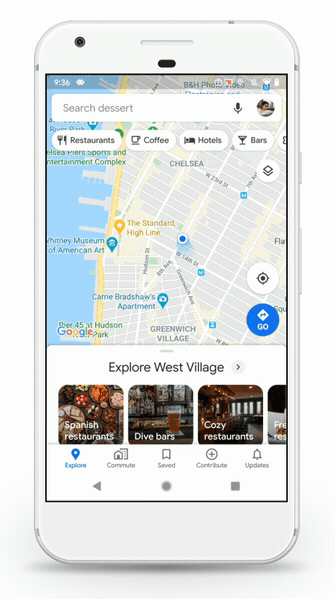Happy 15th birthday to Google Maps, the company’s second most important product
Google updates the app that embodies its commitment to local search.
Refreshed app, new features. There’s also the fact that Google Maps has more than one billion monthly active users and can deliver turn-by-turn navigation almost anywhere in the world. Celebrating its 15th anniversary this week, Google introduced a refreshed version of app for Android and iOS with some new features:
- There are now five (not three) tabs at the bottom of the map screen: Explore, Commute, Saved, Contribute (photos, reviews, content), Updates (feed of recommended places). These supersede the previous Explore, Commute and For You. The idea is to provide quick access to more content and to get more content from users.
- Google is also adding new content about public transit based on user input: Temperature, Accessibility, Women’s Section (region-specific) and Security information.
- Google added that it’s going to expand its Live View augmented reality walking directions, which are built on top of Street View’s imagery. Live View will also gain new capabilities in the near future.

Billions and billions invested. Google Maps has grown from a Mapquest imitator when it launched in 2005 to the most important single local search tool in the market. Google has not disclosed the specific amount of money invested to build Maps – it has spent “many billions of dollars” over the past 15 years — but the global scale and ambition of Google Maps is mind-boggling. Here are a few statistics to illustrate that:
- Google Maps has “comprehensive data for over 200 countries and territories.”
- Information on more than 150 million locations/places.
- 40 million miles of roads.
- 25 million data updates on a daily basis.
Global reach and scale. Google has also grown its Local Guides program of content creators and editors, from 5 million in 2016 to 120 million across 24,000 locations globally. This program has helped Google become the number one reviews platform in North America (by volume) though not without some problems.
Google Maps is also a critical part of the company’s self-driving car initiative. And then there’s the audacity of Street View. The 360-degree photography program features more than 10 million miles of images, captured by cars, bikes, boats and on foot. Street View is complemented by Google Earth and Satellite images, which together (combined with places data) create a nearly complete digital representation of the physical world.
Recognition of the strategic nature of digital mapping prompted Apple to abandon Google and launch Apple Maps in 2012. Since that time the company has invested billions playing catch up to Google.
Why we care. Google Maps is the top traffic/impression source for real-world businesses. And Google My Business is the most important data source for Maps. In fact, according to data from GatherUp and ThriveHive, Google Maps is now driving significantly more local impressions than Google search. Looking at traffic for 20,000 Google My Business profiles, a 2019 analysis by David Mihm found that Google Maps impressions exceeded search impressions roughly 3 to 1 (72% to 28%).
Over the years Google has sought to monetize Maps in different ways. Google currently shows promoted pins, Local campaigns and ads with location extensions on Maps. And it will be tempting for Google to further monetize the app with discovery/display ads as well.
